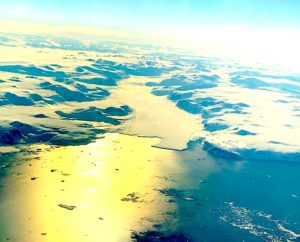
Microplastics in Antarctica are a problem. Microplastics are plastic pieces less than 5mm in size. Though they have been found in surface waters, sediment and snow in Antarctica previously, the continent has been considered relatively safe from this kind of pollution due to its remoteness. Unfortunately, a recent analysis of an ice core drilled in sea ice in 2009 found 96 pieces of plastic in the core, comprised of 14 different kinds of plastic.
Since the microplastic was found in fast ice and surrounded by algae the concern is that krill, the basis of the Antarctic food chain, and who rely on algae for food, will ingest microplastics and no one is sure of the long-term effects.
Sources
It is believed that the sources of the microplastics in Antarctica may be local because the pieces were larger than pieces usually found, which indicates they may not have floated long distances and had time to break down into smaller pieces. The suspects are tourists, (mainly from their clothing), and the fishing industry (where plastic and other rubbish is routinely thrown overboard).
The ice core was retrieved from East Antarctica which has a minimal tourism presence so it is expected that West Antarctica will have a much higher incidence of plastic due to the 50,000 plus tourists that visit there each year
Sub-Antarctic Islands
The sub-Antarctic islands are also recipients of plastic waste. For three decades Scientists from the British Antarctic Survey (BAS) have been collecting marine debris from various islands. The amount of plastic found on beaches peaked in the 1990’s and the good news is that measures to reduce plastic are having an impact though the total number of items collected has increased.
Many birds on these islands ingest plastic and it has been found that much of the plastic is in the form of food wrapping. Since a number of these birds scavenge behind fishing boats the most obvious culprits are the many fishing boats that ply these waters. Without oversight there is nothing to stop them from throwing waste overboard.
This was brought home to me many years ago while working on ships. I found two 44 gallon drums of oil and rags sitting on the deck of a ship I was loading and asked the captain what they were for. He said that as soon as they got out to sea they would toss the drums overboard.
I said ‘Why not dispose of them back in Malaysia?’ (the ship’s home country). He said that the owners would not want to pay for disposal and that if he forced the issue they would just sack him and replace him with a more compliant captain. That was 40 years ago and I doubt anything has changed.
Much more policing is needed to bring these people into line but in the meantime you can minimise your own use of plastics.
If we want to keep Antarctica as pristine as possible then we need to up our game.
Plastics and climate change
Why? Because it’s an ongoing battle against greed and destruction. If you’re concerned about climate change then we should be focusing on minimising plastics (since they are something you have personal control over). Plastics contribute almost 4% of global CO2 emissions. That’s almost double the emissions of the aviation sector. If it were a country, plastic would be the fifth-highest emitter in the world.
Generally, microplastics are plastic fragments less than 5 mm in size, whereas, nano-plastics are so minute that they are not visible to the naked eye or even under a simple optical microscope. There are microplastics in Antarctica and nano-plastics as well.
Nano-plastic are formed when larger plastics break down and are probably spread by air currents. They have been discovered recently at both the poles, indicating these tiny particles are widespread. If Antarctica has them at the South Pole then nowhere is safe. (Check out my blog post about climate change https://captainantarctica.com.au/is-climate-change-happening-to-us-or-for-us/)
Cellular damage
We are only just beginning to understand the damage caused by small plastic particles. They have been shown to damage cells in humans and other organisms. Cellular damage increases with the amount of microplastics absorbed and currently we are each ingesting a heaped dinner plate worth of microplastics each year.
With almost 400 million tonnes of plastics produced annually – and growing – the nano-plastics problem is not going away. Oil companies are expecting a compound growth rate of 3.4% and plastics are very cheap to make and the profits are good. So, there is no incentive for them to stop.
Still, I’m hopeful we will get our act together. So it comes down to us. If you want to minimise the microplastics in Antarctica, start minimising the use of plastics in your life and do the Earth and yourself a favour. You might want to read this article as well. Some groups are trying to do something about it. https://time.com/5818225/microplastics-antartica/

